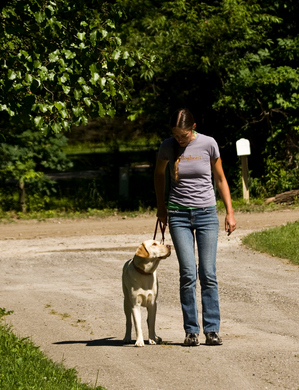Collars, leashes and puppies: How to get moving in right direction with your new dog

Liz and Tia do some leash work.
Photo by Jerry Buffman
The puppy's natural reaction to being restrained is to rebel. Pet stores know this, and hence the popularity of products like head halters, prong collars, bags and bags of treats, remote training collars, invisible fence systems and cinching harnesses. While I am not inherently against using tools, I believe that if you start right with a young pup, you can avoid needing any of them.
Puppies just wanna be free.
The last thing I want to do when beginning directional training with a puppy is send him the message that I am going to take away his freedom; instead, I want the pup to trust that moving harmoniously with me equals freedom. A puppy between the ages of 3 and 7 months is in the most impressionable stage of learning. Mother dog would have you know that a poetic balance of respect and trust, combined with focus, consistency and patience are far better tools than anything you will find on the pet store shelves.
The critical elements of directional harmony:
1) Don't rush the introduction to collar and leash. It's fine to have your pup wear her new collar for a few days before you attach anything to it. I combine putting the collar on with positive things like comforting physical interactions, feeding, and yard time. Draw little attention to the collar; keep it casual and calm.
2) When you finally do get “connected,” don't use a short leash or retractable. Use a longer (15' or more) light line. I prefer a material that is really light but strong and doesn't soak up moisture (quarter-inch poly-wrap from the hardware store works great). This long line gives your marginally coordinated puppy more freedom to move and you more time to respond to their unpredictable agenda.
3) Practice in a low-distraction environment initially. No need to be competing with neighborhood stimulation. Take the pup to a relatively quiet place and see how it feels to move around together without letting the line encumber the pup. Try to provide your pup with a virtual “off-leash” experience by keeping the line out of her way and drawing as little attention to the connection as possible. Some pups, inevitably, will try to bite at the line; in this case, calmly and consistently try to redirect her attention to moving with you.
4) Don't try to teach too much too soon. Forget about “come,” “heel,” “stay,” and all that more complicated stuff for now. Remember, these are baby steps. The first two cues that I teach the pup are “wait,” meaning to stop, and “this way,” meaning to turn and move in my direction. I just stick with those two at first. Keep it simple and enjoyable. There will be plenty of time later for teaching more cues.
5) Regardless of what training method you use, absolutely NEVER ignore tension in the line. At this stage of the game tension is still meaningful to your pup, and you want to keep it that way. Make it clear that tension means that something is wrong; you both want it to go away. With a little hand coordination, intelligence and patience, you can teach a pup to wait and turn in a very short time.
6) Build on what is working. Once you get your pup stopping and turning on cue you can have fun inspiring him or her to move with you. You are capitalizing on your pup's natural inclination to want to have a partner to enjoy life with. Be interesting and captivating. Put your cell phone away and forget about work for a while. Your pup knows if you are there or not.
7) Be calm, consistent, and have fun!
Learning to move harmoniously with your pup on a long line can strengthen your bond and underscore your authority. As your pup matures, you will have paved the way for good close-quarter leash walking as well as for off-leash reliability. It all starts with the puppy!
John Spieser is a professional trainer and owner of Dogheart. He can be contacted at john@doghearta2.com.


Comments
LA
Wed, Aug 11, 2010 : 8:55 a.m.
After a lifetime of German Shepards and Shepard mixes 10 years ago I brought home a Chocolate Lab. All my experience suddenly left me... at just 4 months he was able to pull down a slight incline and I landed on my stomach. I was desperate. Our vet recommended the Halti - I tried it. It was the most amazing transformation! Just as the pkg promised... within 3 day he was walking calmly by my side! Incredible. I am forever a life long fan of the head halter systems. (After a few week all I had to do was show him the Halti and he'd behave with a traditional collar and leash). He grew up to be a sweet calm and very well trained dog
Jasperebow
Tue, Aug 10, 2010 : 4:31 p.m.
It has taken a relatively long time to get our Border Collies to walk well on a lead. Off leash training beginning with long lead directional work helped us a lot. Herding dogs like hunting dogs are made for open field work. I am sure my neighbors thought there was something wrong with me as I changed directions every few feet to train them to move along with us instead of forging ahead. LOL!
debling
Tue, Aug 10, 2010 : 1:02 p.m.
Always sounds simple. However, I think sometimes it is the breed. I had no trouble with my poodle/terrier. However, my beagle is 10 years old and from day 1 pulls like crazy and does not stop when she chokes herself out. We have tried everything to get her to stop to no avail. She is probably too old to do anything now.